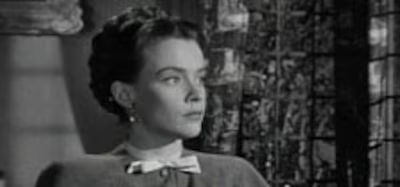The Sign of the Ram

Brief Synopsis
Cast & Crew
John Sturges
Susan Peters
Alexander Knox
Phyllis Thaxter
Peggy Ann Garner
Ron Randell
Film Details
Technical Specs

Synopsis
The peaceful setting of the St. Aubyn family estate, known as Bastions, on England's western coast, masks the troubled state that exists within its walls. It is to this estate that Sherida Binyon has been summoned to serve as personal secretary to the wheelchair-bound poet Leah St. Aubyn. Soon after arriving at Bastions, Sherida is introduced to Leah's husband Mallory and her three stepchildren, Jane, Christine and Logan. As Sherida settles into her new home, Leah continues her flirtation with her physical therapist, Dr. Simon Crowdy. Simon, however, is in love with Jane. Prompted by the gossipy ramblings of her friend, Clara Brastock, Leah begins to have delusions that Sherida and her husband are having an affair. Later, when Leah denies Simon's request for permission to marry Jane, she is subjected to a frank analysis of her problems by the doctor. He tells her that she is exhibiting obsessions that are typical of those born under the astrological sign of the ram, Aries. He also accuses Leah of conditioning Jane to cling to her out of a perverse need to keep her "band of slaves intact." Stung by Simon's words, Leah exacts her revenge by lying to Jane and telling her that Simon confided in her that he thought Jane was getting too serious about their relationship. After attempting to destroy Jane and Simon's relationship, Leah next tries to drive a wedge between Logan and his new love, Catherine Woolton. She does not succeed, however, and the couple eventually announce their betrothal and intention to move to London. One day, while Logan is gone on a trip, Leah summons Catherine to the house and tells her lies about her estranged parents. This time, Leah succeeds in breaking up the couple when Catherine believes her claim that Logan fled to London after learning that there was insanity in her family. Devastated by Leah's words, Catherine vows never to see Logan again, then disappears. Her disappearance is soon explained by a suicide note that she wrote, which is delivered to Bastions by Catherine's stepfather. A search for Catherine leads Mallory and others to Echo Cove, where she is rescued from death by Mallory. Logan eventually discovers his stepmother's lies, and he and Jane both vow never to return to Bastions. Meanwhile, the confused Christine, having been told by Leah that Sherida is the source of the family's troubles, attempts to kill Sherida by poisoning her with an overdose of pills. With the extent of Leah's sinister machinations obvious to all, Christine is sent away to boarding school and the St. Aubyn family lies in ruin. Now driven to desperation by her family's rejection, Leah wheels herself to the edge of an oceanside cliff and falls to her death.

Director

John Sturges
Cast

Susan Peters

Alexander Knox

Phyllis Thaxter

Peggy Ann Garner

Ron Randell

Dame May Whitty
Allene Roberts
Ross Ford
Diana Douglas
Margaret Tracy
Paul Scardon
Gerald Hamer

Doris Lloyd
Gerald Rogers
Crew
Charles Bennett
Clay Campbell
Sturges Carne
Irving Cummings Jr.
Jack Goodrich
Stephen Goossón
Burnett Guffey
Helen Hunt
Jean Louis
Wilbur Menefee
James Nicholson
Hans J. Salter
Aaron Stell
M. W. Stoloff
Frank [a.] Tuttle

Videos
Movie Clip


Film Details
Technical Specs

Articles
Sign of the Ram
Peters was one of several fascinating actresses of the '40s -- including Audrey Totter and Marsha Hunt -- who never rose as high as their talents deserved. Whereas the others' career problems could be blamed on the shortsightedness of studio executives, Peters was the victim of a freak accident. After making her name at MGM, where she won a Best Supporting Actress Oscar® nomination for Random Harvest (1942), she was on the verge of stardom. In 1944 the studio even listed her among ten players, including Esther Williams and Gene Kelly, promoted from featured player to star status. Then a hunting accident left her paralyzed from the waist down. To his credit, studio head Louis B. Mayer paid her medical bills and kept her under contract even after it was clear she would never walk again.
Impressed with her talents, however, producer Irving Cummings and his son, Irving Cummings, Jr., joined forces with the Orsatti Agency to produce a comeback film for her. Margaret Ferguson's 1945 novel, The Sign of the Ram, offered the perfect vehicle with its tale of a wheelchair-bound poet living in a remote mansion on the British coast. The bitter young woman's only solace is a flirtation with her doctor (Ron Randell), but when she learns he is in love with her stepdaughter, interest turns to obsession, and she starts manipulating those around her to keep herself the center of attention .
The Cummings' secured a production deal with Columbia Pictures, where The Sign of the Ram was shot with contributions from such studio talent as cinematographer Burnett Guffey and rising young director John Sturges. They also surrounded her with a top-notch cast, including Canadian actor Alexander Knox, who had scored as the U.S. president in the title role of Wilson(1944), and Phyllis Thaxter, on loan from Peters' old studio, MGM. Best of all were another MGM veteran, Dame May Whitty, and child star Peggy Ann Garner. Whitty delivered her last screen performance as the malicious gossip who first plants the seeds of suspicion in Peters' mind. She finished her last scene briefly before her death from cancer. Garner had won a special Oscar® for her performance in A Tree Grows in Brooklyn (1945), but was having trouble finding other suitable roles as a young adult. In The Sign of the Ram, she played the family bad seed, whose devotion to Peters makes her act as the disturbed woman's legs, helping to spread rumors and trying to poison Thaxter.
Ultimately, however, Peters was the whole show. Her alabaster beauty and surface calm provided a perfect mask for her malicious schemes. She focused much of her inner life on the characters' hands, which dominate the film like a pair of spiders as she smokes endless cigarettes, plays the piano and writes poison-pen notes. It was a worthy comeback, but it wasn't enough to revive her career. Critics at the time were not receptive to the film's merits, complaining about Sturges' slow pacing and the melodramatic aspects that have made it so popular among later fans. Its box-office failure marked the end of Peters' film career. She would attempt a TV series, Miss Susan (1951), in which she played a wheelchair-bound detective, and toured to great acclaim in two plays -- The Glass Menagerie and The Barretts of Wimpole Street -- with roles that could accommodate her physical condition. With no other prospects and a life of almost constant pain, she starved herself to death in 1952, at the age of only 32. Fans captivated by her work continue to treasure the relatively small number of films in which she had a chance to excel. The Sign of the Ram is almost the Holy Grail for them, never released on video or DVD and rarely screened at revival houses.
Producer: Irving Cummings, Jr.
Director: John Sturges
Screenplay: Charles Bennett
Based on the novel by Margaret Ferguson
Cinematography: Burnett Guffey
Art Direction: Stephen Goosson, Sturges Carne
Music: H.J. Salter
Principal Cast: Susan Peters (Leah St. Aubyn), Alexander Knox (Mallory St. Aubyn), Phyllis Thaxter (Sherida Binyon), Peggy Ann Garner (Christine St. Aubyn), Ron Randell (Dr. Simon Crowdy), Dame May Whitty (Clara Brastock).
BW-84m.
by Frank Miller

Sign of the Ram
Quotes
Trivia
Notes
This film marked the return of actress Susan Peters to the screen after a three-year absence due to an accident in 1945 that left her wheelchair-bound. It was also her final film. In the early 1940's, Peters was billed as Suzanne Carnahan, her real name. Peters' last previous picture was the 1945 film Keep Your Powder Dry. According to a contemporary article in New York Times, producer Irving Cummings and his son Irving Cummings, Jr. formed the independent production company Signet Productions in conjunction with the Orsatti Agency, which represented Susan Peters. The article also notes that Signet signed a distribution deal with Columbia, which provided production facilities for them. Peters reportedly received thirty-three percent of the film's profits. According to a pre-production Hollywood Reporter news item, some background filming was set to take place at Lizard's Head, in Cornwall, England.














